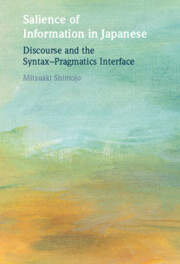Book contents
- Salience of Information in Japanese
- Salience of Information in Japanese
- Copyright page
- Contents
- Figures
- Tables
- Preface
- Abbreviations
- Notes on Transcriptions
- 1 Introduction
- 2 Background
- 3 Backward-Looking Salience and Argument Forms
- 4 Backward-Looking Salience and Argument Forms
- 5 Predicate-Less Constructions
- 6 Forward-Looking Non-salience and Argument Forms
- 7 Concluding Remarks
- References
- Index
4 - Backward-Looking Salience and Argument Forms
RRG Representations
Published online by Cambridge University Press: 28 March 2024
- Salience of Information in Japanese
- Salience of Information in Japanese
- Copyright page
- Contents
- Figures
- Tables
- Preface
- Abbreviations
- Notes on Transcriptions
- 1 Introduction
- 2 Background
- 3 Backward-Looking Salience and Argument Forms
- 4 Backward-Looking Salience and Argument Forms
- 5 Predicate-Less Constructions
- 6 Forward-Looking Non-salience and Argument Forms
- 7 Concluding Remarks
- References
- Index
Summary
With the observations of the usage of zero and topicalized arguments discussed in chapter 3, this chapter applies the findings to RRG and shows how the observed regularities are captured in the theory. This chapter pays special attention to interfaces with discourse-pragmatics in the theory, particularly bidirectional interactions between syntax and pragmatics. The discussion begins with the focus structure of sentences, which is then integrated with the salience hierarchies proposed in chapter 3. This is followed by the discussion of linking between semantic and syntactic representations, which also involves discourse representation structures. The bidirectional interactions with discourse representation structures capture not only the discourse influence on syntax but also the other direction of the interface, i.e. how the speakers’ forward-looking intentions, manifested by the morphosyntactic realization of information, influence discourse representation structures.
- Type
- Chapter
- Information
- Salience of Information in JapaneseDiscourse and the Syntax–Pragmatics Interface, pp. 113 - 155Publisher: Cambridge University PressPrint publication year: 2024



